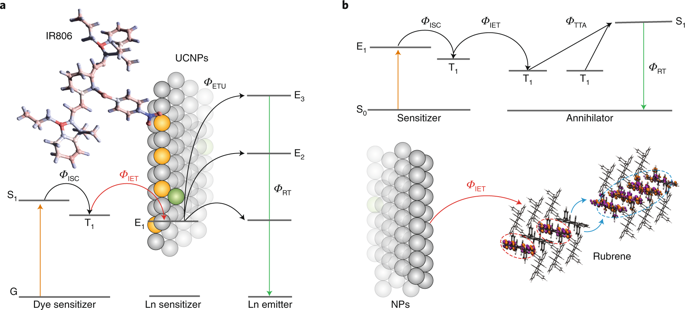Nature Photonics ( IF 35.0 ) Pub Date : 2019-10-28 , DOI: 10.1038/s41566-019-0528-x Shihui Wen , Jiajia Zhou , P. James Schuck , Yung Doug Suh , Timothy W. Schmidt , Dayong Jin

|
To improve the efficiency of photon upconversion, a hybrid approach of combining organic dyes and inorganic nanoparticles is proving successful, especially in the form of dye-sensitized lanthanide-doped upconversion nanoparticles, nanoparticle-sensitized molecular triplet–triplet annihilation systems and metal–organic-framework nanoparticles. In this Review, we survey the latest advances and examine the key factors affecting upconversion performance, such as spectral overlap, core–shell design and the management of triplet excitons and quenchers at the interface between materials. Although issues such as stability, triplet-state quenching, concentration quenching and reabsorption must still be overcome, smart designs of hybrid nanosystems offer exciting opportunities for applications such as solar photovoltaic devices, deep-tissue biomedical imaging, optogenetics and nanomedicine among others.
中文翻译:

混合上转换纳米系统的未来和挑战
为了提高光子上转换的效率,有机染料和无机纳米粒子相结合的混合方法被证明是成功的,尤其是以染料敏化掺杂镧系元素的上转换纳米粒子,纳米粒子敏化的分子三重态-三重态三重态an灭体系和金属-有机物的形式。骨架纳米颗粒。在本综述中,我们调查了最新进展,并研究了影响上转换性能的关键因素,例如光谱重叠,核-壳设计以及材料之间界面处的三重态激子和猝灭剂的管理。尽管仍然必须克服诸如稳定性,三重态猝灭,浓度猝灭和重吸收之类的问题,但是混合纳米系统的智能设计为诸如太阳能光伏设备,


























 京公网安备 11010802027423号
京公网安备 11010802027423号